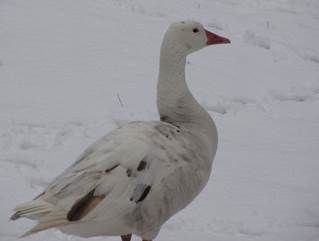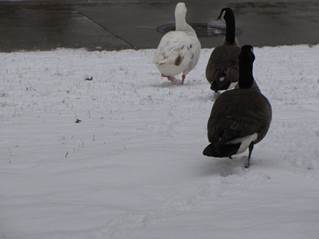Why Don’t Birds' Feet and Legs Get Frostbite?
By Wildlife and Industry Together (WAIT)
February 2, 2017

Photo courtesy of Barbara Dietz
Adaptation and change is for the thin skinned. Cold feet and warm heart? There must be more to it.
Are there times when a question just won’t go away and begs for an answer? Yes!
Are the reasons known? Our NIEHS reporters and researchers, when faced with this question, scrambled to find out. The Gurus hit the books and Internet, while other employees were dispatched into the field to get the latest poop*. This investigation was to be a complete and thorough attempt with nothing left to speculation.
The feet and legs of birds don’t have much insulating fat, no feathers, and few nerves. These factors coupled with cold temperatures should severely reduce blood flow and eventually lead to cell death due to loss of nutrients and warmth from the blood.

Photo courtesy of Bill Willis
The first stop on our quest was to visit local stores and distributors to check for waterproof outerwear. Asking clothiers and outfitters for protective foot and leg apparel didn’t get us far.
Store employees said that we were the first to ask for such items. They provided little advice, but did give us puzzled looks and chuckles that are always helpful. A pet store might be a possibility, as well as the local GALS**. If small blankets, jackets, and booties are made for dogs in cold weather, maybe they’d have something. We discovered that without demand, no inventory was carried. With so many migratory and resident bird populations, it would seem that demand would be high. We were starting to get a little down.

Turns out the research Gurus were having better luck online. After an intensive Internet search, a couple items were discovered that looked practical. Unfortunately, the Goose Boots and Duck Boots were manufactured only in human sizes. However, other designs stood out, but a call to the Internet sellers revealed that these items although colorful, were more novelty than practical. Orders were not flying off the shelves. These were not suitable for cold winter activities.
The field reporters went to Discovery Lake to talk with the animals. Hopefully, they’d learn more about why the ducks and geese weren’t fully protected. When reporters approached the geese and ducks with this question, the birds either hissed or waddled away from the interviewers. Like with the salespeople, our employees got strange looks and undecipherable fowl comments. Getting nowhere fast at this rate; were down coats alone adequate? Maybe the wrong question was being asked. Was it something about the animals themselves that protected them from cold injury?
NIEHS employees also said that they had never seen ducks or geese wearing shoes or leggings, not even famous ones like Donald Duck or Big Bird. The pendulum began to swing more toward Physiology and away from Materialism. Who can or will speak for the birds? NIEHS is fortunate to have a Bird named Gary on campus. We asked Gary for insight into why Birds don’t cover their extremities. The answer, while uniquely English, should not be applied broadly to all species. “Birds (feet, legs), as well as marine mammals (flippers) have a heat exchange network to protect those appendages”, he said. Gary, as a Human Bird, also has a rudimentary system for countercurrent blood heat exchange deep in his arms and legs that protects his core temperature but does little to prevent frostbite.
Compelled to get at the truth, and nothing but the truth, The Librarians were consulted. Walleye! Nothing magical! The real facts started to surface. A book by John Nedwidek entitled Ducks Don’t Wear Socks, Viking Press, 2008 said that if Ducks wore socks then they couldn’t be serious. Our fowl are very serious.
As The Librarians found out, aquatic birds, as well as many perching birds, don’t require additional clothing, for temperature is regulated internally. These birds have a counter-current heat exchange system between the arteries and veins in their legs. Warm arterial blood flowing down to the feet passes close to cold venous blood returning from the feet. The arterial blood warms up the venous blood, dropping in temperature as it does so. Once in the body, the temperature returns to 41oC and the cycle is repeated and the feet stay a rather constant temperature, above freezing.
When walking on ice or swimming in icy waters, the feet approach freezing but never reach it. Both humans and some birds also practice sitting on their feet to keep them warm. Standing on one leg or sitting on the ground may help warm the feet. The feet may be cool but the heart stays warm.
Possible exceptions do exist. Frostbite can occur during very harsh winters, or when there is a sudden temperature drop. Allowing your goose or duck to play in the snow or ice skate after being cooped up for days may bring on frostbite since the feet aren’t acclimated to the abrupt change.
The counter current blood flow also allows the birds to cool themselves if they get too hot during the summer. Although not a perfect system, it beats changing before going outside.
Notable Notes
*Poop = scoop, inside info, lowdown
**GALS = Get A Life Store
The author is pleased to bring this information to your attention to eliminate any concerns the public may have had. No animals or environmental features were harmed or modified (embarrassed maybe) during the course of this quest for answers.
References



